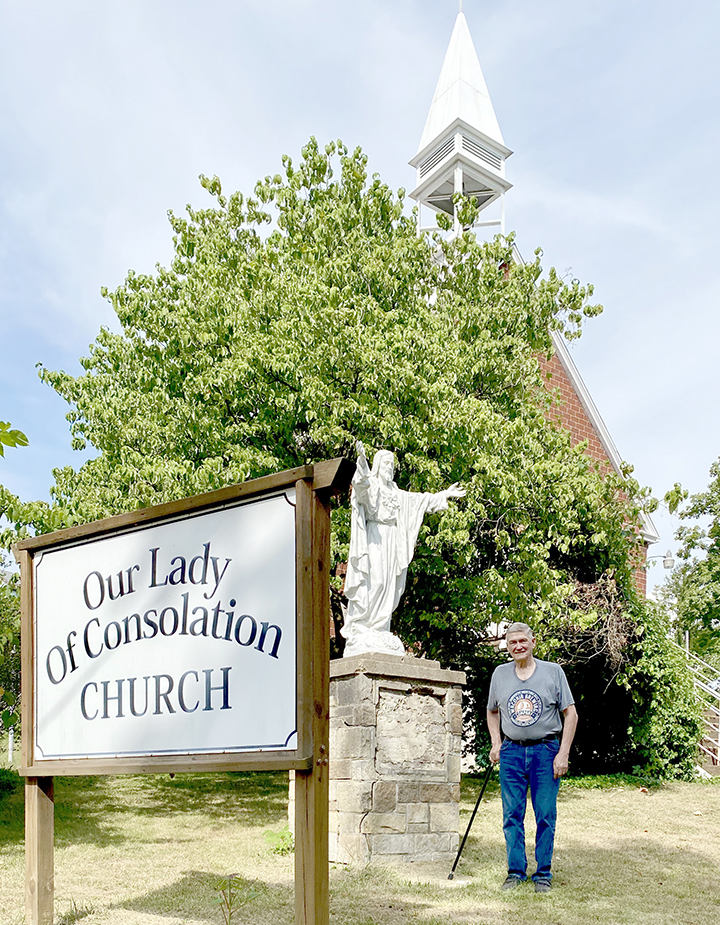The drive to Our Lady of Consolation Catholic Church from the UMWA Union Hall involves taking a hard right at the end of the row of original company houses that flank the street behind the hall. My front wheels grab the edge of the road as the view of the town below emerges from the greenery. I’m following UMWA president Adam McKean, the self appointed protector of this now empty church. The speaker in its steeple once rang the hours of 6 a.m. and 6 p.m. with bells and chimes, along with carols on Christmas.
When the Diocese of Pittsburgh decided to consolidate resources, dwindling congregations were a major consideration. St. Thomas in Clarksville, Sacred Heart in Rices Landing, St. Mary in Crucible and Our Lady of Consolation in Nemacolin would close their churches and merge with St. Hugh in Carmichaels. Parishioners voted to rename the parish St. Matthias and Father Albin McGinnis and Father Francis Frazer continue to officiate over St. Hugh, St. Ann in Waynesburg, St Ignatius in Bobtown and St. Marcellus in Jefferson. They deliver weekday and weekend masses, with weekday mass also posted live online for the homebound.
“You could hear the bells ringing all over town. I miss that.” To Adam, going to St. Hugh now is no problem. “Church to me is where I am when they’re doing mass. I’ve done mass in fields, in barracks, in basilicas, in little churches.”
We walk around the building, past the front steps where Adam had his wedding photos taken in 1976 and around the corner to the empty frame parsonage, attached to the brick walls of the church proper. There are bowls by the back door someone fills with food for stray cats. Near the corner of the back fence is what I remember being charmed by when I was here in 2018 for the funeral of my sister’s father-in-law Leonard Udovich. Two small curved benches in front of a little stone grotto that still glows with gold paint. Looking inside I see the statue of Mary has left her grotto. Plastic lilies lie scattered in the grass and all that remains inside is the face of her Son on a prayer card, shrouded in plastic, looking back at me with shadowed eyes. Father Nazemick had the grotto made, Adam tells me. “Used to have a cross on top but kids knocked it off.” Nuns and novices would sometimes stay in the parsonage during the summer, parish priests would sometimes live here for their tenure. Adam remembers being asked by resident priests to do repairs and sometimes being inspired to prank the good father, coal miner style. Like the time he put a nickel in the end of the parish hose and screwed it back on the faucet head….
Is this church on the market? Adam shakes his head. “We haven’t heard.”
When Buckeye Coal Company envisioned its model industrial town in 1917, churches for their Protestant and Catholic workers were part of the plan. Lots were set aside but it would be years before churches were built. Our Lady of Condolences celebrated its first mass on December 25, 1928 and would finally close in 2018, a few months after the funeral that brought me here with my extended family to say goodbye to Big Len.
Adam has more stories to tell. The church was burned during one of the wildcat mine strikes of the late 1920s into the depression years. “The company turned off the water all over town and the boiler blew up. Parishioners got together to fix it, even the Protestants helped.”
Robert Korcheck’s book tells us that when tensions between UMWA workers and the company police exploded into a riot on December 2, 1933, teargas was used and a number of protestors were chased to the church by mounted police. “Many lay bleeding and exhausted on the church steps as police charged them. At this point Father Joseph Altany…. in spite of objections from police ordered them with language not customarily used by the clergy off church property.”
The statue of Jesus still stands beside the church signage on the front lawn. Adam remembers the morning a few years after the mine closed, when he found it pitched head down on the lawn. It took his father in law’s tractor and a handful of strong men to get it back on its pedestal and properly glued and bolted in place. “But some of the fingers were damaged so Len Udovich took it home first and fixed them.”
I look into the sky and see the upraised hands, every finger perfect. I think of the years spent celebrating Russian Christmas at Big Len’s house overlooking the river, high above Pershing Boulevard. I think of our extended family gathered around him and the twinkle that never seemed to leave his eyes when he was with the ones he loved. Of course Big Len fixed those fingers. He was one of the best mine mechanics around. He could fix anything!
